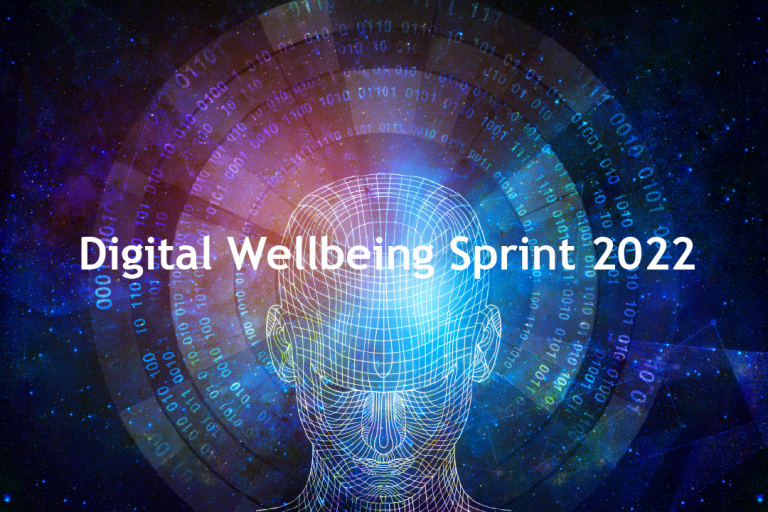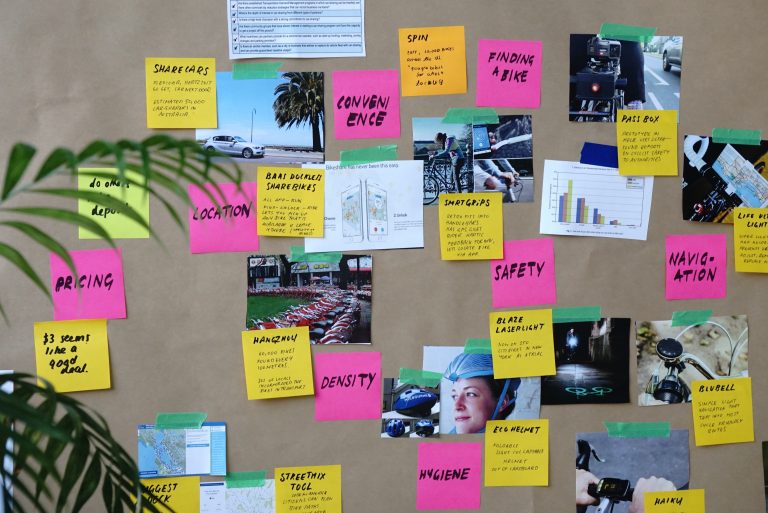How to create a fruitful design sprint? Insights from a facilitator to another
In a design sprint, a team with different skills and personalities go through certain steps, creating a tested prototype in only five days. During Digital Wellbeing Sprint in May 2021, our student teams did the same in a slightly modified process. Instead of five days, we had seven. And more importantly, because of the covid-19 situation, we had to do this all in a virtual environment. What are the key elements for a facilitator to consider in a design sprint? In this blog post, I want to give some insights for creating a successful design sprint from a facilitator’s perspective.
The design sprint is probably most often used when new digital services are created. However, this doesn’t need to be the case. A sprint can be used in various industries when new solutions are needed. What does a sprint mean, concretely? Typically, a sprint means an accelerated phase of development. It is both a methodology and a state of mind. A sprint is effective, when the participating team is committed and distribute their work accordingly in order to achieve a common goal. To get to this, the team needs a superb facilitator to help them keep on track. Could that be you?
My advice for a facilitator is following:
🗝 Keep all materials in one place
🗝 Build cohesion in your team
🗝 Trust the people
🗝 Give just enough time
🗝 No for too detailed instructions
🗝 Trust the process
I’ll cover all of these in more detail in the following paragraphs. Most of the facilitation tips are valid in both live and virtual events. I put extra effort on guidance in virtual venue, so that you can avoid some fatal mistakes if you’re planning a remote design sprint!
Keep all materials in one place
When realizing a virtual sprint, you need to be extra careful to keep people on board. Literally. We used a platform for virtual whiteboard to create a common space for sprint teams. We customized the template for Official 5-Day Design Sprint in Miro to meet our needs. Other (and in my opinion the only) relevant option for a co-creation platform would be Mural. In Miro, you can do almost everything sprint related, even host the meeting. If you need to share files (consider if that’s really necessary), you have to have another platform or tool as well.
By using a single source for creating and ideating, people can take much in by just a glance. A virtual whiteboard is an essential tool to so that people can remind themselves with what you have created, accomplished and agreed on previous stages. Isn’t it annoying to open and close files so that you can find what you are looking for? Using a virtual whiteboard in sprint tackles this.
Build cohesion in your team
A solid cohesion and open atmosphere are a must in a design sprint. In a design process, we often talk about divergence and convergence. This means that you need to move between ideation and decision-making phases, one after another. In a divergent phase, more ideas or opportunities are sought. This is followed by convergent phase, in which the pieces come together, and you seek for a clear decision. Without an atmosphere where all thoughts and ideas from all participants are welcome, trust and psychological safety are at risk. This can lead to lack of innovation and thus failing to accomplish initial goals.
You can build cohesion and group spirit with various means. Remember to take enough breaks, and try to encourage discussion. The list of warm-ups and energizers is endless. Google will take you far with finding best energizers for virtual or live events. My favourite listings can be found from Skybound, Impact by Design, and Hyperisland’s Toolbox. With your facilitation style, it is possible to reinforce trust, empathy, and creativity in your team.
Trust the people
In a virtual sprint, it is difficult or even impossible to have total control of the team as a facilitator. But don’t you worry even though you’re not in charge. It can be difficult to cope with the uncertainty the physical distance brings but the sprint is not about you. As a facilitator, you’re there only to make things easier.
Most likely, you’re facilitating the work of capable and skilled professionals. They are adults, and you can’t control what they actually do or don’t do. Based on that, the only thing you can do is to trust that everyone does their part. In the beginning of the sprint, perhaps more instructions and guidance are needed, but as the days go on, the team will start to work more or less autonomously. Their challenge drives and motivates them, and you can stay in the back unless the team needs you.
Give just enough time
Planning the schedule for your sprint is one of the most crucial preparation tasks. Your role as a facilitator is to take care that the schedule is being followed. Not respecting your carefully planned schedule is as useful as stealing money from yourself. By lagging, you snitch time from all the tasks you need to complete later.
At times, the sprint might feel chaotic and hectic. It’s easy to get stuck on details and prolong conversations. However, hurrying up at some phases during the sprint won’t hurt, as long as you complete all tasks. As a facilitator, your role is to remind the team about the big picture: the sprint is all about innovative ideas and testing them. What you’re developing during the sprint doesn’t have to be flawless. You’re risking your team’s wellbeing and sprint goals if you keep stretching the schedule.
No for too detailed instructions
When you’re running a design sprint for the first time, it’s easy to babble endlessly about what to do next. You can be even a little confused yourself because you don’t know what to expect. But you know what? The same goes for your team. They’re just as eager, anxious, excited, and confused as you are. They don’t remember half of what you just explained. Rather than telling people what to do, show them, and then let them do it themselves.
In a design process in general, concrete doing beats theoretical planning. You’ll achieve a lot more, when you just start doing instead of trying to find consensus of how to proceed. If people are not familiar with the programs or platforms you use, they won’t learn them by you teaching them. They’ll learn by doing. In addition, a design sprint is the perfect place to try new, crazy things in a structured way. Don’t stifle your team’s creativity and ideas by too detailed instructions, they’ll only get confused and restricted.
Trust the process
In the beginning, it might feel a little overwhelming that you should have a working prototype after only a few short days. In Digital Wellbeing Sprint 2021, we had six student teams with different challenges and partner companies. All of them completed the sprint with a tested prototype and a spectrum of insights for the client.
Simply, the design sprint methodology works. Just trust the process.

Text by Johanna Hentunen, a master student of service design in Laurea UAS. Johanna has a long experience in facilitating workshops, interviews, and events. This was her first take on design sprint, but definitely not the last. Currently, Johanna works at Business Jyväskylä, enhancing ecosystem networking among different stakeholders to create growth and boost innovation. Let’s connect on LinkedIn!





